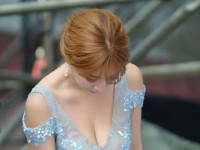动画[6]PropertyAnimator LayoutTransition
来源:互联网 发布:淘宝招聘信息 编辑:程序博客网 时间:2024/06/02 01:20
【参考链接】
LayoutTransition(布局容器动画)http://www.bubuko.com/infodetail-826585.html
从API 11开始,Android为ViewGroup提供了setLayoutTranslation()方法
通过为ViewGroup指定LayoutTranslation,当ViewGroup调用addView()、removeView(),或者子View调用setVisiblity()等方法时,子View能够产生动画效果。
/**
* This class enables automaticanimations on layout changes in ViewGroup objects. To enable
* transitions for a layoutcontainer, create a LayoutTransition object and set it on any
* ViewGroup by calling {@link ViewGroup#setLayoutTransition(LayoutTransition)}.This will cause
* default animations to runwhenever items are added to or removed from that container. To specify
* custom animations, use the {@linkLayoutTransition#setAnimator(int, Animator)
* setAnimator()} method.
*
* <p>One of the core concepts of thesetransition animations is that there are two types of
* changes that cause the transitionand four different animations that run because of
* those changes. The changes thattrigger the transition are items being added to a container
* (referred to as an"appearing" transition) or removed from a container (also known as
* "disappearing").Setting the visibility of views (between GONE and VISIBLE) will trigger
* the same add/remove logic. Theanimations that run due to those events are one that animates
* items being added, one thatanimates items being removed, and two that animate the other
* items in the container thatchange due to the add/remove occurrence. Users of
* the transition may want differentanimations for the changing items depending on whether
* they are changing due to anappearing or disappearing event, so there is one animation for
* each of these variations of thechanging event. Most of the API of this class is concerned
* with setting up the basicproperties of the animations used in these four situations,
* or with setting up customanimations for any or all of the four.</p>
*
* <p>By default, the DISAPPEARING animationbegins immediately, as does the CHANGE_APPEARING
* animation. The other animationsbegin after a delay that is set to the default duration
* of the animations. This behaviorfacilitates a sequence of animations in transitions as
* follows: when an item is beingadded to a layout, the other children of that container will
* move first (thus creating spacefor the new item), then the appearing animation will run to
* animate the item being added.Conversely, when an item is removed from a container, the
* animation to remove it will runfirst, then the animations of the other children in the
* layout will run (closing the gapcreated in the layout when the item was removed). If this
* default choreography behavior isnot desired, the {@link#setDuration(int, long)} and
* {@link #setStartDelay(int,long)} of any or all of the animations can be changed as
* appropriate.</p>
可以设置如下4种情况的动画效果
LayoutTransition.APPEARING
当添加一个View时,此View的动画效果
LayoutTransition.DISAPPEARING
当移除一个View时,此View的动画效果
LayoutTransition.CHANGE_APPEARING
当添加一个View时,会发生位置移动的其他View的动画效果
LayoutTransition.CHANGE_DISAPPEARING
当移除一个View时,会发生位置移动的其他View的动画效果
并且,会等CHANGE_APPEARING执行完以后才执行APPEARING,等DISAPPEARING执行完以后才执行CHANGE_DISAPPEARING
我们可以直接使用系统默认的动画效果,也可以设置自己的。
以如下代码为例,设置LinearLayout的添加删除子View时的动画效果
//默认的LayoutTransition
layoutTransition=newLayoutTransition();
ll.setLayoutTransition(layoutTransition);
defaultAppearingAnim=layoutTransition
.getAnimator(LayoutTransition.APPEARING);
defaultDisappearingAnim=layoutTransition
.getAnimator(LayoutTransition.DISAPPEARING);
defaultChangingAppearingAnim=layoutTransition
.getAnimator(LayoutTransition.CHANGE_APPEARING);
defaultChangingDisappearingAnim=layoutTransition
.getAnimator(LayoutTransition.CHANGE_DISAPPEARING);
//自定义的Appearing动画:以Y为轴翻转
customAppearingAnim= ObjectAnimator.ofFloat(null,"rotationY",90f,0f)
.setDuration(layoutTransition.getDuration(LayoutTransition.APPEARING));
//自定义的Disappearing动画:以X为轴翻转
customDisappearingAnim= ObjectAnimator.ofFloat(null,"rotationX",0f,90f)
.setDuration(layoutTransition.getDuration(LayoutTransition.DISAPPEARING));
//后面两个动画必须得叠加这4个属性//并且后面两个动画的of()中的values不能为2个值,不然没有效果
//不知道为什么!!!
PropertyValuesHolderpvhLeft = PropertyValuesHolder.ofInt("left",0,1);
PropertyValuesHolderpvhTop = PropertyValuesHolder.ofInt("top",0,1);
PropertyValuesHolderpvhRight = PropertyValuesHolder.ofInt("right",0,1);
PropertyValuesHolderpvhBottom = PropertyValuesHolder.ofInt("bottom",0,1);
//PropertyValuesHolderpvhScrollX = PropertyValuesHolder.ofInt("scrollX", 0, 1);
//PropertyValuesHolder pvhScrollY = PropertyValuesHolder.ofInt("scrollY",0, 1);
// 自定义的ChangeAppearing动画
PropertyValuesHolderpvhScaleX = PropertyValuesHolder.ofFloat("scaleX",1f,0f,1f);
PropertyValuesHolderpvhScaleY = PropertyValuesHolder.ofFloat("scaleY",1f,0f,1f);
customChangingAppearingAnim= ObjectAnimator.ofPropertyValuesHolder(newObject(),pvhLeft,pvhTop,pvhRight,
pvhBottom,pvhScaleX,pvhScaleY)
.setDuration(layoutTransition.getDuration(LayoutTransition.CHANGE_APPEARING));
//自定义的ChangeDisappearing动画
PropertyValuesHolderpvhRotation = PropertyValuesHolder.ofFloat("rotation",0f,360f,0f);
////或者通过这样来定义
//Keyframe kf0 = Keyframe.ofFloat(0f, 0f);
//Keyframe kf1 = Keyframe.ofFloat(.9999f, 360f);
//Keyframe kf2 = Keyframe.ofFloat(1f, 0f);
//PropertyValuesHolder pvhRotation =PropertyValuesHolder.ofKeyframe("rotation", kf0, kf1, kf2);
customChangingDisappearingAnim= ObjectAnimator.ofPropertyValuesHolder(newObject(),pvhLeft,pvhTop,pvhRight,
pvhBottom,pvhRotation)
.setDuration(layoutTransition.getDuration(LayoutTransition.CHANGE_DISAPPEARING));

- 动画[6]PropertyAnimator LayoutTransition
- 动画[3]PropertyAnimator ValueAnimator
- 动画[4]PropertyAnimator ObjectAnimator
- 动画[5]PropertyAnimator AnimatorSet
- LayoutTransition设置动画
- LayoutTransition 容器布局动画
- Android容器动画LayoutTransition
- LayoutTransition 容器布局动画
- LayoutTransition 布局动画笔记
- Android 动画之LayoutTransition
- Android布局动画--LayoutTransition
- 布局动画 LayoutTransition
- Android动画Animation/Animator/LayoutTransition
- 布局动画之LayoutTransition使用
- LayoutTransition(布局容器动画)
- android动画--animateLayoutChanges与LayoutTransition
- Android动画 animateLayoutChanges与LayoutTransition
- android 动画之 属性动画propertyAnimator(一)
- Redux(三: React-Redux)
- SpringMVC @RequestBody接收Json对象字符串
- NGUI_的Anchor的制作_007
- windbg符号路径
- 树莓派3操作系统下载地址
- 动画[6]PropertyAnimator LayoutTransition
- assign-----魔法赋值
- CentOS7 安装 gitlab
- HBase Shell 常用操作
- 使用susy内置混合宏异常:Undefined mixin 'at-breakpoint'
- Redis配置祥解
- PHP将Base64图片转换为本地图片并保存
- 2007版以上的Matlab如何自动调正格式,自动对齐
- C# unicode string 转换 codepoint


